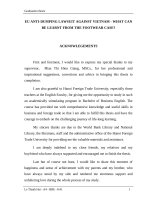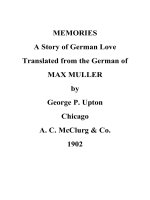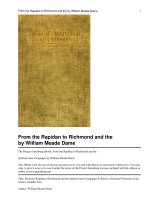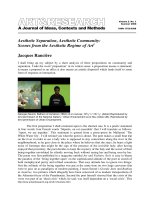CAN AESTHETIC THEORIES OF ART BE RESCUED FROM THE PROBLEM OF AVANT-GARDE AND OTHER NON-PERCEPTUAL ARTWORKS? – AN EXPLORATION OF NON-PERCEPTUAL AESTHETIC PROPERTIES pdf
Bạn đang xem bản rút gọn của tài liệu. Xem và tải ngay bản đầy đủ của tài liệu tại đây (75.16 KB, 11 trang )
Postgraduate Journal of Aesthetics, Vol. 4, No. 1, April 2007
C
AN
A
ESTHETIC
T
HEORIES OF
A
RT
B
E
R
ESCUED
F
ROM THE
P
ROBLEM OF
A
VANT
-G
ARDE AND
O
THER
N
ON
-P
ERCEPTUAL
A
RTWORKS
?
– A
N
E
XPLORATION OF
N
ON
-P
ERCEPTUAL
A
ESTHETIC
P
ROPERTIES
.
A
NGHARAD
S
HAW
U
NIVERSITY OF
N
OTTINGHAM
Proponents of the aesthetic theory of art advocate that the aesthetic domain
encompasses all artworks. However, there is a belief that although much art falls under
the aesthetic, there are some artworks that do not. Avant-garde artworks are offered as
counterexamples to the aesthetic theory as they are artworks that reject the very idea of
the aesthetic. This paper explains the idea of non-perceptual aesthetic properties and
explores whether it can incorporate avant-garde artworks into the domain of the
aesthetic.
James Shelley, in his 2003 paper ‘The Problem of Non-Perceptual Art’, describes
the problem as the inconsistency of the following three propositions: artworks
necessarily have aesthetic properties that are relevant to their appreciation as artworks
(proposition R); aesthetic properties necessarily depend, at least in part, on properties
perceived by means of the five senses (proposition S); and there exist artworks that
need not be perceived by means of the five senses to be appreciated as artworks
(proposition X).
1
The aesthetic theory of art attempts to answer the question ‘what makes something a
work of art?’ by supplying a general theory based upon aesthetic properties, which are
properties that depend on properties perceived by the senses (propositions (R) and (S)).
1
Shelley (2003), p.363.
A
NGHARAD
S
HAW
29
Avant-garde works cause problems for aesthetic descriptions of artworks because
properties other than those received by the five senses lead people to consider them art
(proposition X).
It is important to note that an interest in the way something looks is not necessarily
an aesthetic interest. For example, to look at an artwork to see whether it is a painting or
a collage is to take a non-aesthetic interest in it. It is not this sort of interest we are
concerned with when discussing properties relevant to the appreciation of objects as
artworks. Aesthetic theories of art focus upon artworks necessarily having aesthetic
properties that are relevant to their appreciation as artworks.
One of the earliest examples of the avant-garde, or non-perceptual art, is Marcel
Duchamp’s Fountain: an existing urinal placed in a gallery in 1917. Among the most
philosophically interesting things about this work are the facts that: (a) many people
consider Fountain a work of art; (b) it was intended to make a statement rather than be
appreciated for its aesthetic qualities; (c) the fact that it is specifically a urinal has no
impact upon the work (it could be any object that achieves the same effect); (d) a
description of the work is sufficient to appreciate it as an artwork; and (e) there exist
many identical urinals that are not considered to be artworks.
Several attempts have been made to confront the problem of avant-garde artworks
and rescue aesthetic theories of art. An obvious reaction is to deny that works such as
Fountain are in fact art. This serves to shrink the domain of art to that of the aesthetic.
This is inadequate as it avoids the issue and the need to explain why many people call
avant-garde works ‘art’. James Shelley describes this strategy as the first version of ‘the
first solution’ to the problem of non-perceptual art. Using the aforementioned
propositions, proponents of the first solution accept (R) and (S) but simply deny (X).
The second version of Shelley’s description of the first solution denies (X) but on
different grounds: avant-garde artworks are aesthetic because they have perceptible
aesthetic properties such as pleasing curves and shiny surfaces. Advocates of
avant-garde works as art believe that such an approach misses the point: Duchamp’s
intention was to create a conceptual statement about art, not an aesthetically interesting
or pleasing object. This defence of proposition (X) is challenged by avant-garde
artworks that are less easily appreciated as artworks in virtue of their perceptual
aesthetic properties. Shelley uses Timothy Binkley’s comments regarding Duchamp’s
L.H.O.O.Q (a defaced copy of the Mona Lisa with the letters L.H.O.O.Q at the bottom)
to illustrate the point:
A
NGHARAD
S
HAW
30
“Excursions into the beauty with which the moustache was drawn or the delicacy with
which the goatee was made to fit the contours of the face are fatuous attempts to say
something meaningful about the work of art. If we do look at the piece, what is important
to notice is that there is a reproduction of the Mona Lisa, that a moustache had been
added, etc. It hardly matters exactly how this was done, how it looks”.
2
The current orthodox aesthetic theory of art is more sophisticated than either version
of the first solution. Shelley labels this theory ‘the second solution’ and describes it as
accepting propositions (S) (aesthetic properties depend on properties perceived by the
five senses) and (X) (there are some artworks that can be appreciated as such without
being perceived by the five senses) but rejecting proposition (R) (artworks necessarily
have aesthetic properties that are relevant to their appreciation as artworks).
The second solution accepts that literature and works such as L.H.O.O.Q and
Fountain are artworks and is compatible with Duchamp’s view that to look at the
aesthetic qualities of his works misses the point. However, it is not a work’s aesthetic
properties that defines it as art. This raises the important question as to what does make
them art. Shelley suggests that the appreciation of non-perceptual art could depend on
there being some sort of non-aesthetic properties that play a corresponding role to that
played by aesthetic properties in the appreciation of aesthetic art. Or, alternatively, the
appreciation of non-aesthetic art could depend on nothing corresponding to the
perception of aesthetic properties in the appreciation of aesthetic art. He argues that:
“if the appreciation of non-aesthetic art should turn out to be radically unlike the
appreciation of aesthetic art, the first-solution advocate would have a new reason for
asserting the discontinuity of allegedly non-aesthetic art with aesthetic art, and hence for
rejecting the [second-solution advocate’s] claim to the status of art”.
3
I think a further consequence of claiming that the appreciation of non-aesthetic art is
very unlike the appreciation of aesthetic art is that it would strengthen arguments for
aesthetic theories’ rival theories of art. This is because it leads us to think that not all art
can be appreciated aesthetically, so we must seek an alternative general theory.
2
Binkley in Shelley (2003), p.369. Emphasis in original.
3
Shelley (2003), p.369.
A
NGHARAD
S
HAW
31
Aesthetic theories of art must thus avoid making such a claim.
Shelley also argues that to say that the appreciation of non-aesthetic, or avant-garde,
artworks depends on properties playing a role matching that played by aesthetic
properties in appreciating aesthetic art leads to the problem of how these properties
manage to play such a role without being aesthetic properties. He states that
second-solution advocates
“tend to attribute non-perceptual artworks properties that appear to stand to those works
as standard aesthetic properties stand to perceptual works. Danto, for example, attributes
daring, impudence, irreverence, wit, and cleverness to Fountain”.
4
Second-solution defenders will agree that there are many similarities between
non-perceptual properties, such as wit and daring, and perceptual aesthetic properties.
However, their point is that aesthetic properties are essentially perceptual, properties
such as wit and daring are not perceptual (so they cannot be aesthetic), avant-garde
works are appreciated as art because of these non-perceptual properties; therefore it is
not the case that artworks necessarily have aesthetic properties that are relevant to their
appreciation as artworks.
This is a valid rejection of proposition (R) and one with which Shelley agrees to in
part. However, he states,
“my disagreement with the second-solution advocate concerns only what we mean, or
perhaps ought to mean, when we say that aesthetic properties are essentially
perceptual”.
5
The issue here is whether aesthetic properties being perceptual means that they can be
directly perceived (with or without the five senses) or whether they are perceived via
properties that are perceived (e.g. the way something looks). Shelley states
“The second-solution advocate is obviously committed to the latter, which is simply a
restatement of (S) [that aesthetic properties necessarily depend, at least in part, on
properties perceived by means of the five senses]”.
6
4
Shelley (2003), p.370.
5
Shelley (2003), p.371.
6
Shelley (2003), p.371.
A
NGHARAD
S
HAW
32
Shelley reacts against (S) and proposes ‘the third solution’ as a way to incorporate
avant-garde artworks into the aesthetic theory of art. The third solution invokes the idea
of non-perceptual aesthetic properties and takes the following form: it accepts (R) and
(X) but denies (S).
7
Shelley’s main reason for denying (S) is that aesthetic properties
strike us. Shelley quotes Frank Sibley to help explain this notion:
“…People have to see the grace and unity of a work…feel the power of a novel, its mood,
or its uncertainty of tone. They may be struck by these qualities at once, or they may
come to perceive them only after repeated viewings, hearings, or readings, and with the
help of critics…the crucial thing is to see, hear, or feel”.
8
This does not reduce to the idea that aesthetic properties are perceived via properties
that are perceived (i.e. the idea of perception that Shelley has rejected) because feeling
the power of a novel or seeing that Fountain is witty does not come from the sight of the
words or the gleaming curves of the urinal. Rather, these non-perceptual aesthetic
properties strike us and are thus perceived directly, not through the five senses.
The third solution allows us to say that daring and wit are just as aesthetic as grace
and elegance because these properties strike us, they are felt. So Fountain, L.H.O.O.Q
and literature are artworks. The domain of the aesthetic has been stretched to
encompass all art, even the avant-garde and the similar troubling case of literature.
Shelley’s third solution also explains the philosophically interesting points I raised in
my initial discussion of Duchamp’s Fountain. I shall now take each point in turn.
In light of the third solution, that Fountain was intended to make a statement rather
than be appreciated for its aesthetic qualities no longer seems opposed to our notion of
what an artwork is. This is because we can concede that conceptual artworks can be
understood as embodying ideas and that such artworks can be appreciated for their
non-perceptual aesthetic qualities, e.g. their wit, without alluding to their perceptual
aesthetic qualities, e.g. curves.
It is also no longer concerning that Fountain being specifically a urinal has no
impact upon the work. This is because when we appreciate Fountain as an artwork we
do not appreciate it because it is an aesthetically pleasing object. We notice that it is an
7
Shelley (2003), p.363.
8
Sibley as quoted in Shelley (2003), p.372.
A
NGHARAD
S
HAW
33
object not usually exhibited in an art gallery (which leads us to be struck by its wit and
daring); it could be any object that produces the same non-perceptual aesthetic
properties.
It is true that a description of an avant-garde work is sufficient to appreciate it as an
artwork. According to the third solution, we are struck by the daring and wit of
Fountain when we read about it not because we see the urinal but because it is a urinal
(or an object that has the same effect). We can be struck by the non-perceptual aesthetic
properties because they do not depend upon us using our five senses to infer their
presence, to quote Noël Carroll, “we do not have to hear [or see] the work to be moved
thusly; nevertheless, in being so moved the connection with feeling marks the property
as aesthetic”.
9
There exist many urinals identical to Fountain that are not considered to be art. This
is not a problem for the third solution because it can explain Fountain’s special status in
terms of the non-perceptual aesthetic properties that Fountain possesses but other
urinals do not. The point above that Fountain could be any object backs this
explanation.
Shelley’s third solution justifies many of our intuitions regarding avant-garde
artworks. However, I am concerned that it may lead to confusion about what constitutes
an artwork. Part of the daring and wit of Fountain is derived from the outrage of many
art-lovers who may not have perceived the work’s wit or daring. It might be thought
that Shelley’s solution would lead us to extend the work to these comments. However, I
believe Shelley would say that such art-lovers had failed to properly appreciate the
artwork and that what makes Duchamp’s works daring and witty is what they are and
where they are. A response might be that the work must extend to its context. Would it
be fair to say that the artwork Fountain is composed of a urinal and a gallery or the
established ideas of the art world? It does not appear that the third solution draws clear
lines for where avant-garde artworks stop and reality/regular objects/spaces begin.
Noël Carroll voices the most damaging criticisms of Shelley’s proposal. He draws
attention to the fact that there are further artworks whose status as artworks cannot be
explained by the third solution. So Shelley’s conclusion, that all art has now been
explained, is too hasty. Shelley broadened the domain of the aesthetic to encompass
more artworks but if there still exist artworks that fall outside of the aesthetic domain,
9
Carroll (2004), p.419.
A
NGHARAD
S
HAW
34
these too must be explained by a good general theory of art.
Carroll states that if artworks necessarily have aesthetic properties (perceived or not)
and there exist artworks that do not strike us, i.e. “that leave us indifferent when it
comes to feeling”
10
, then Shelley has not rescued the aesthetic theory. Carroll states that
artworks that leave us unmoved
“are what we call bad art; but it is important to remember that bad art is still art…the
aesthetic approach still seems ill-suited for dealing with bad art”.
11
Carroll suggests rewriting the definition of art so that “something is an artwork only if it
is intended to focus attention upon its [perceptual or non-perceptual] aesthetic
properties”.
12
So, bad artworks can be art because they aim to draw attention to their
aesthetic properties but fail to provide them. However, as Carroll notes, this creates
further difficulties: there exist artworks that are not intended to focus attention upon
their aesthetic properties (whether perceived or not). He presents tribal masks as an
example because they were intended to scare enemies, not draw attention to their
aesthetic properties.
13
Carroll states his conclusion as, although he agrees with Shelley that conceptual art
“may possess aesthetic properties and support aesthetic experience, appropriately
understood, I do not believe that this significant finding lends credence to the persuasion
that art is essentially or necessarily aesthetic. For one will still have to show that all
artworks are designed with the primary intention of focusing attention upon their
aesthetic properties. And this seems to me, for historical and anthropological reasons, to
remain implausible”.
14
If this conclusion cannot be successfully challenged, the aesthetic theory of art will be
in jeopardy. I believe it is worth exploring ways in which we might rescue Shelley’s
third solution, and therefore the aesthetic theory of art.
A simple way to side-step Carroll’s objection would be to deny that artworks that do
not intend to focus attention on their aesthetic properties are art. However, as I
10
Carroll (2004), p.421.
11
Carroll (2004), p.421. Italics in original.
12
Carroll (2004), p.421.
13
Carroll (2004), p.421.
14
Carroll (2004), p.422.
A
NGHARAD
S
HAW
35
explained earlier in this essay, this is defeatist.
Another easy way to challenge Carroll’s conclusion might be to state that anything
placed in a gallery is an artwork. However, this would not satisfy Shelley’s own idea of
the aesthetic. Such a suggestion moves away from the aesthetic theory firmly into the
realm of its main rival - the institutional theory.
Shelley could try to challenge Carroll’s premise that there are artworks that are not
intended to provoke consideration of their aesthetic properties. This is not an easy task
and is certainly no quick fix as all that is needed to challenge Shelley’s solution is the
existence of one counterexample. Shelley could begin by trying to explain the art status
of Carroll’s example - tribal masks.
Tribal masks were made with the intention of scaring enemies and are now
considered to be art, so Carroll argues. Given this, Shelley has several lines of attack:
(a) tribal masks are not considered art, (b) tribal masks were not specifically intended to
scare enemies, and (c) intending to scare enemies involves focusing attention upon the
work’s aesthetic properties. I think (a) is obviously false and that (b) would deny
art-historical evidence. It appears that (c) is Shelley’s best strategy.
If a mask is intended to scare, could we argue that ‘scariness’ is a non-perceptual
aesthetic property in the same way that wit or daring are? If so, then the tribal masks are
intended to focus attention upon their aesthetic properties and are therefore safely now
considered art, according to the third solution, despite whether art was a concept
employed or considered when the masks were made.
It could be said that scariness strikes us in the requisite manner. But is this just fear
rather than a property the artefact has? I think the fear is a consequence of the scariness
in the way that amusement may result from the wit of Fountain. To re-quote Carroll’s
description of Shelley’s solution: “…in being so moved the connection with feeling
marks the property as aesthetic”
15
, this appears to give further justification for calling
scariness a non-perceptual aesthetic property because scariness moves us.
However, it is not so clear that scariness is an aesthetic property as it can be the case
that artworks are scary without scary being an aesthetic property. But Shelley has
already argued that if there are properties playing the role corresponding to the one
played by aesthetic properties, we have little reason to deny that they are aesthetic
properties.
It seems that scariness does play the role played by aesthetic qualities so it is
15
Carroll (2004), p.419.
A
NGHARAD
S
HAW
36
difficult to deny its non-perceptual aesthetic property status without denying wit and
daring that status. However, it seems more intuitive to call daring and wit
non-perceptual aesthetic properties than it is to call scariness an aesthetic property.
Herein lies the crux of this problem: where do we draw the line, if there is one,
between properties that just cause feeling and genuine aesthetic properties? Shelley’s
third solution needs to be strengthened by the inclusion of an explanation of whatever
underpins the intuition that there is a difference between scariness and wit.
Tribal masks are not avant-garde artworks so it might be said that Shelley’s third
solution has accounted for avant-garde works thus removing the majority of
counterexamples to the aesthetic theory of art. However, the nature of avant-garde art
means that since the era of Duchamp’s readymade artworks, the boundaries have been
pushed further, to the point where some new avant-garde artworks appear to fall outside
Shelley’s aesthetic theory of art. A contemporary, and controversial, example is
Carsten Holler’s Test Site presently being exhibited at the Tate Modern Gallery,
London (April 2007).
Test Site is five five-story-high glass and steel slides that the public can ride. The
artist describes it as “a device for experiencing an emotional state that is somewhere
between delight and madness”
16
, but is it art? In 2006 The Scotsman newspaper
declared: “it’s a bloody helter-skelter…If I put a hook-a-duck stall in Tate Modern
would that be ‘art’ too?”
17
Shelley might argue that The Scotsman correspondent missed the point. Other than
Test Site’s obvious perceptible aesthetic properties, the work strikes us as amusing,
exciting and technically impressive. Being technically impressive certainly does not
qualify Test Site as an artwork (artworks can be appreciated for things other than what
makes them art) but amusement and excitement seem candidates for being
non-perceptual aesthetic properties. However, at this point we fall foul of the same
difficulty the third solution had with the tribal masks: is there enough intuitive appeal to
call amusement and excitement non-perceptual aesthetic properties?
A further worry concerning excitement as a non-perceptual aesthetic property is that
it seems dependent upon the five senses. Test Site is only exciting for those
experiencing sliding down the slides. If excitement is a property of the work in this way
16
Holler in The Scotsman 2006.
17
The Scotsman 2006.
A
NGHARAD
S
HAW
37
it seems dependent on someone presently experiencing the slide. Does this mean that
Test Site is only an artwork when someone is using the slides (i.e. the artwork is
extended to encompass the objects and the experience)? That seems counterintuitive.
Avant-garde artworks were the standard damaging objection to aesthetic theories of
art. However, the idea that there are non-perceptual aesthetic properties provides a way
to incorporate classic examples of avant-garde artworks in the domain of the aesthetic.
Since the era of Duchamp’s Fountain, avant-garde artworks have developed to the
point of once again challenging the aesthetic theory of art. Counterexamples such as
Test Site highlight that more work needs to be done to the non-perceptual aesthetic
properties theory in order to preserve the aesthetic theory of art. Particular attention
needs to be paid to the explanation of the intuition that some properties that strike us are
not non-perceptual aesthetic properties. There needs to be criteria for determining what
counts as a non-perceptual property and what does not. At present, Shelley’s theory
goes some way in expanding the domain of the aesthetic to incorporate avant-garde
artworks. However, part of the art domain remains outside of that of the aesthetic.
Artworks in this area remain counterexamples to the aesthetic theory of art.
A
NGHARAD
S
HAW
38
R
EFERENCES
C
ARROLL
,
N.
(2004). ‘Non-Perceptual Aesthetic Properties: Comments for James
Shelley.’ British Journal of Aesthetics, Vol. 44, No. 4, pp. 413-423.
The Scotsman, Sat 14
th
October 2006. ‘Burning Questions: Does Tate Modern’s New
Helter-Skelter Work as Art?’ Accessed online (Fri 20
th
October 2006):
S
HELLEY
,
J.
(2003). ‘The Problem of Non-Perceptual Art.’ British Journal of
Aesthetics, Vol. 43, No. 4, pp. 363-378.









